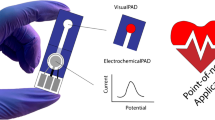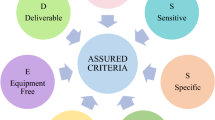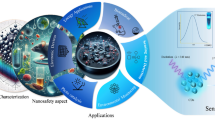Abstract
This work describes a simple, rapid, and cost-effective method for fabrication of paper-based carbon electrode (US$ <0.01) using conductive ink based on powdered graphite and nail polish, supported on cardboard paper to sulfanilamide electrochemical determination by differential pulse voltammetry. The device was characterized by Raman spectroscopy, scanning electron microscopy (SEM), and electrochemical impedance spectroscopy (EIS). Raman spectra showed the characteristic bands of graphite structures, D and G at 1350 and 1582 cm−1, respectively. SEM images revealed a porous and heterogeneous surface that contributes to the high electroactive area, while EIS demonstrated a greater ease of electronic transfer compared whit commercial glassy carbon electrode. The device presented a simple and highly reproducible construction process (RSD <5.7%). The method was applied to sulfanilamide determination in samples of lake and seawater, synthetic urine, otologic solution, and milk. The electrochemical method showed an excellent analytical performance with a detection limit of 4.1 µmol L−1, wide linear range from 10 to 100 µmol L−1, adequate precision (RSD <2.0%), and recovery values ranging from 80 to 102% for the spiked samples analysis and minimum sample preparation step (simple dilution). Thus, the disposable proposed device proves to be a promising analytical tool for in routine analyzes of clinical, environmental, and food samples.






Similar content being viewed by others
References
Rousham EK, Unicomb L, Islam MA (2018) Human, animal and environmental contributors to antibiotic resistance in low-resource settings: integrating behavioural, epidemiological and One Health approaches. Proc Royal Soc B Biol Sci 285:20180332
Sobrinho GL, Oliveira AJd, Sobrinho FSL, Silva RRd, Oliveira LCd, Fernandes AP, Botero WG (2021) Application of natural organic residue to remove sulfanilamide in an aquatic environment. Environ Chall 2:100010
Huang W, Qiu Q, Chen M, Shi J, Huang X, Kong Q, Long D, Chen Z, Yan S (2019) Determination of 18 antibiotics in urine using LC-QqQ-MS/MS. J Chromatogr B 1105:176–183
Wacheski T, Hara ELY, Soares BGS, Silva BJGd, Abate G, Grassi MT (2021) o-DGT Devices for the determination of emerging contaminants in aqueous matrices. Journal of the Brazilian Chemical Society 32:72–82
Ganiyu SO, de Araújo MJG, de Araújo Costa ECT, Santos JEL, dos Santos EV, Martínez-Huitle CA, Pergher SBC (2021) Design of highly efficient porous carbon foam cathode for electro-Fenton degradation of antimicrobial sulfanilamide. Appl Catal B Environ 283:119652
Errayess SA, Lahcen AA, Idrissi L, Marcoaldi C, Chiavarini S, Amine A (2017) A sensitive method for the determination of sulfonamides in seawater samples by solid phase extraction and UV–visible spectrophotometry. Spectrochim Acta Part A Mol Biomol Spectrosc 181:276–285
Ahmed AA, Thiele-Bruhn S, Aziz SG, Hilal RH, Elroby SA, Al-Youbi AO, Leinweber P, Kühn O (2015) Interaction of polar and nonpolar organic pollutants with soil organic matter: Sorption experiments and molecular dynamics simulation. Sci Total Environ 508:276–287
Anh HQ, Le TPQ, Da Le N, Lu XX, Duong TT, Garnier J, Rochelle-Newall E, Zhang S, Oh N-H, Oeurng C, Ekkawatpanit C, Nguyen TD, Nguyen QT, Nguyen TD, Nguyen TN, Tran TL, Kunisue T, Tanoue R, Takahashi S, Minh TB, Le HT, Pham TNM, Nguyen TAH (2021) Antibiotics in surface water of East and Southeast Asian countries: a focused review on contamination status, pollution sources, potential risks, and future perspectives. Sci Total Environ 764:142865
Najlaoui D, Echabaane M, Ben Khélifa A, Rouis A, Ben Ouada H (2019) Photoelectrochemical impedance spectroscopy sensor for cloxacillin based on tetrabutylammonium octamolybdate. J Solid State Electrochem 23:3329–3341
Moutab Sahihazar M, Ahmadi MT, Nouri M, Rahmani M (2019) Quantum conductance investigation on carbon nanotube–based antibiotic sensor. J Solid State Electrochem 23:1641–1650
Wang J, Chu L, Wojnárovits L, Takács E (2020) Occurrence and fate of antibiotics, antibiotic resistant genes (ARGs) and antibiotic resistant bacteria (ARB) in municipal wastewater treatment plant: an overview. Sci Total Environ 744:140997
Amarasiri M, Sano D, Suzuki S (2020) Understanding human health risks caused by antibiotic resistant bacteria (ARB) and antibiotic resistance genes (ARG) in water environments: current knowledge and questions to be answered. Crit Rev Environ Sci Technol 50:2016–2059
Parra KN, Gul S, Aquino JM, Miwa DW, Motheo AJ (2016) Electrochemical degradation of tetracycline in artificial urine medium. J Solid State Electrochem 20:1001–1009
Yáñez-Sedeño P, Pedrero M, Campuzano S, Pingarrón JM (2021) Electrocatalytic (bio)platforms for the determination of tetracyclines. J Solid State Electrochem 25:3–13
Wu Y-h, Bi H, Ning G, Xu Z-g, Liu G-q, Wang Y-h, Zhao Y-l (2020) Cyclodextrin subject-object recognition-based aptamer sensor for sensitive and selective detection of tetracycline. J Solid State Electrochem 24:2365–2372
Montemurro N, Joedicke J, Pérez S (2021) Development and application of a QuEChERS method with liquid chromatography-quadrupole time of flight-mass spectrometry for the determination of 50 wastewater-borne pollutants in earthworms exposed through treated wastewater. Chemosphere 263:128222
Georgiadis D-E, Tsalbouris A, Kabir A, Furton KG, Samanidou V (2019) Novel capsule phase microextraction in combination with high performance liquid chromatography with diode array detection for rapid monitoring of sulfonamide drugs in milk. J Sep Sci 42:1440–1450
Sereshti H, Khosraviani M, Sadegh Amini-Fazl M (2014) Miniaturized salting-out liquid–liquid extraction in a coupled-syringe system combined with HPLC–UV for extraction and determination of sulfanilamide. Talanta 121:199–204
Yang L, Zhou S, Xiao Y, Tang Y, Xie T (2015) Sensitive simultaneous determination of three sulfanilamide artificial sweeters by capillary electrophoresis with on-line preconcentration and contactless conductivity detection. Food Chem 188:446–451
Chen S, Wang C, Zhang M, Zhang W, Qi J, Sun X, Wang L, Li J (2020) N-doped Cu-MOFs for efficient electrochemical determination of dopamine and sulfanilamide. J Hazard Mater 390: 122157
Ferraz BRL, Guimarães T, Profeti D, Profeti LPR (2018) Electrooxidation of sulfanilamide and its voltammetric determination in pharmaceutical formulation, human urine and serum on glassy carbon electrode. J Pharm Anal 8:55–59
Li H, Kuang X, Shen X, Zhu J, Zhang B, Li H (2019) Improvement of voltammetric detection of sulfanilamide with a nanodiamond−modified glassy carbon electrode. Int J Electrochem Sci Total Environ 14:7858–7870
Tadi KK, Motghare RV, Ganesh V (2014) Electrochemical detection of sulfanilamide using pencil graphite electrode based on molecular imprinting technology. Electroanalysis 26:2328–2336
Vanoni CR, Winiarski JP, Nagurniak GR, Magosso HA, Jost CL (2019) A novel electrochemical sensor based on silsesquioxane/nickel (II) phthalocyanine for the determination of sulfanilamide in clinical and drug samples. Electroanalysis 31:867–875
Wei X, Xu X, Qi W, Wu Y, Wang L (2017) Molecularly imprinted polymer/graphene oxide modified glassy carbon electrode for selective detection of sulfanilamide. Prog Nat Sci Mater Int 27:374–379
de Faria LV, Lisboa TP, Matias TA, de Sousa RA, Matos MAC, Munoz RAA, Matos RC (2021) Use of reduced graphene oxide for sensitive determination of sulfanilamide in synthetic biological fluids and environmental samples by batch injection analysis. J Electroanal Chem 892:115298
de Faria LV, Lisboa TP, Campos NdS, Alves GF, Matos MAC, Matos RC, Munoz RAA (2021) Electrochemical methods for the determination of antibiotic residues in milk: a critical review. Anal Chim Acta 338569
Pradela-Filho LA, Araújo DAG, Takeuchi RM, Santos AL (2017) Nail polish and carbon powder: an attractive mixture to prepare paper-based electrodes. Electrochim Acta 258:786–792
Nurak T, Praphairaksit N, Chailapakul O (2013) Fabrication of paper-based devices by lacquer spraying method for the determination of nickel (II) ion in waste water. Talanta 114:291–6
Ciniciato GPMK, Lau C, Cochrane A, Sibbett SS, Gonzalez ER, Atanassov P (2012) Development of paper based electrodes: from air-breathing to paintable enzymatic cathodes. Electrochim Acta 82:208–213
Santhiago M, Henry CS, Kubota LT (2014) Low cost, simple three dimensional electrochemical paper-based analytical device for determination of p-nitrophenol. Electrochim Acta 130:771–777
Ren Y, Ji J, Sun J, Pi F, Zhang Y, Sun X (2020) Rapid detection of antibiotic resistance in Salmonella with screen printed carbon electrodes. J Solid State Electrochem 24:1539–1549
de Oliveira GCM, Camargo JR, Vieira NCS, Janegitz BC (2020) A new disposable electrochemical sensor on medical adhesive tape. J Solid State Electrochem 24:2271–2278
Camargo JR, Orzari LO, Araújo DAG, de Oliveira PR, Kalinke C, Rocha DP, Luiz dos Santos A, Takeuchi RM, Munoz RAA, Bonacin JA, Janegitz BC (2021) Development of conductive inks for electrochemical sensors and biosensors. Microchem J 164:105998
Laube N, Mohr B, Hesse A (2001) Laser-probe-based investigation of the evolution of particle size distributions of calcium oxalate particles formed in artificial urines. J Cryst Growth 233:367–374
de Araujo Andreotti IA, Orzari LO, Camargo JR, Faria RC, Marcolino-Junior LH, Bergamini MF, Gatti A, Janegitz BC (2019) Disposable and flexible electrochemical sensor made by recyclable material and low cost conductive ink. J Electroanal Chem 840:109–116
Borah M, Dahiya M, Sharma S, Mathur RB, Dhakate SR (2014) Few layer graphene derived from wet ball milling of expanded graphite and few layer graphene based polymer composite. Mater Focus 3:300–309
Inam A, Brydson R, Edmonds DV (2020) Raman spectroscopy study of the crystallinity of graphite formed in an experimental free-machining steel. Mater Charact 163: 110264
Rocha DP, Dornellas RM, Cardoso RM, Narciso LCD, Silva MNT, Nossol E, Richter EM, Munoz RAA (2018) Chemically versus electrochemically reduced graphene oxide: improved amperometric and voltammetric sensors of phenolic compounds on higher roughness surfaces. Sens Actuat B Chem 254:701–708
Wang J (2006) Analytical electrochemistry, 3rd, Edition. WILEY-VCH, New York
Zhang X, Zhang Y-C, Zhang J-W (2016) A highly selective electrochemical sensor for chloramphenicol based on three-dimensional reduced graphene oxide architectures. Talanta 161:567–573
Faria LV, Lima AP, Araújo FM, Lisboa TP, Matos MAC, Munoz RAA, Matos RC (2019) High-throughput amperometric determination of tetracycline residues in milk and quality control of pharmaceutical formulations: flow-injection versus batch-injection analysis. Anal Methods 11:5328–5336
Faria LV, Pereira JFS, Azevedo GC, Matos MAC, Munoz RAA, Matos RC (2019) Square-wave voltammetry determination of ciprofloxacin in pharmaceutical formulations and milk using a reduced graphene oxide sensor. J Braz Chem Soc 30:1947–1954
Ferraz BRL, Profeti D, Profeti LPR (2018) Sensitive detection of sulfanilamide by redox process electroanalysis of oxidation products formed in situ on glassy carbon electrode. J Solid State Electrochem 22:339–346
Funding
This research was supported by FAPEMIG (Research Support Foundation of the State of Minas Gerais) (process: APQ-00197-18), CNPq (National Council for Scientific and Technological Development, process: 307271/2017-0), CAPES (Coordination for the Improvement of Higher Education Personnel, financial code 001) and PROPESQ/UFJF.
Author information
Authors and Affiliations
Corresponding authors
Additional information
Publisher's Note
Springer Nature remains neutral with regard to jurisdictional claims in published maps and institutional affiliations.
Supplementary Information
Below is the link to the electronic supplementary material.
Rights and permissions
About this article
Cite this article
Lisboa, T.P., de Faria, L.V., Alves, G.F. et al. Development of paper devices with conductive inks for sulfanilamide electrochemical determination in milk, synthetic urine, and environmental and pharmaceutical samples. J Solid State Electrochem 25, 2301–2308 (2021). https://doi.org/10.1007/s10008-021-05002-z
Received:
Revised:
Accepted:
Published:
Issue Date:
DOI: https://doi.org/10.1007/s10008-021-05002-z




